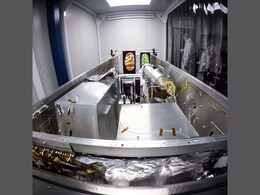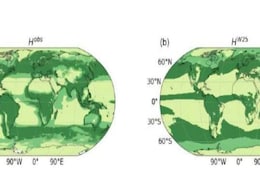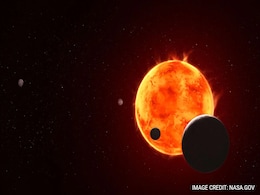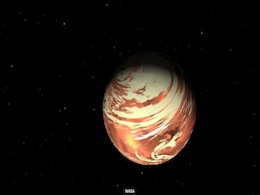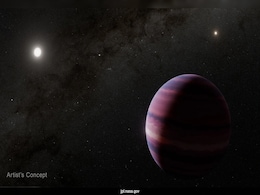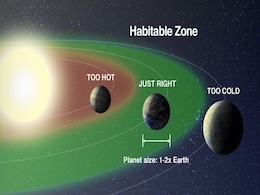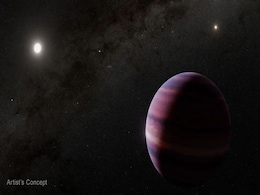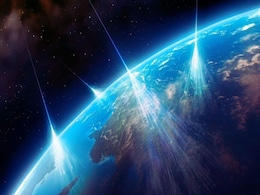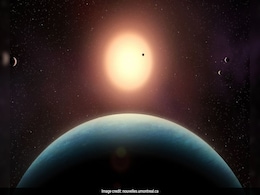Habitable Zone
- All
- News
-

TRAPPIST-1e Methane Signal Likely False, Webb Data Suggests Airless Planet
- Thursday December 11, 2025
The TRAPPIST-1 planetary system, located about 39 light-years from Earth, hosts seven rocky worlds orbiting a cool red dwarf star. While several of these Earth-sized planets lie in the star’s habitable zone, new observations from the James Webb Space Telescope suggest their atmospheres may be too thin to support life. Earlier hints of methane aro...
-
 www.gadgets360.com
www.gadgets360.com
-

Nearby Super-Earth GJ 251 c Could Help Learn About Worlds That Once Supported Life, Astronomers Say
- Sunday November 16, 2025
Astronomers discovered GJ 251 c, a super-Earth 20 light-years away. Its location in the habitable zone and rocky composition make it a top candidate for future searches for life beyond our solar system. The team, led by Suvrath Mahadevan and Corey Beard, said this discovery provides a clock for one of the best candidates to search for life's atmo...
-
 www.gadgets360.com
www.gadgets360.com
-

Newly Found ‘Super-Earth’ GJ 251 c Could Be One of the Most Promising Worlds for Alien Life
- Sunday October 26, 2025
A new super-Earth, GJ 251 c, has been found orbiting a nearby red dwarf star within its habitable zone. About four times Earth’s mass, it may host liquid water. Detected via the radial-velocity method using Penn State’s Habitable Zone Planet Finder, it’s a prime target in the search for life.
-
 www.gadgets360.com
www.gadgets360.com
-

A Better Metric Might Assess The Habitability of Exoplanets: What You Need to Know
- Thursday October 2, 2025
The new three-parameter metric has been introduced by researchers based in England, where this metric will likely be successful in assessing the habitability.
-
 www.gadgets360.com
www.gadgets360.com
-

Not Like Venus Or Mars, Distant Exoplanet May Have Atmosphere Like Earth's
- Friday September 19, 2025
- World News |
A distant exoplanet might have an atmosphere similar to Earth's, early observations from the James Webb Space Telescope (JWST) suggest. It is part of a group of planets orbiting a star called TRAPPIST-1, about 40 light-years away from Earth.
-
 www.ndtv.com
www.ndtv.com
-

NASA Telescope Detects Possible Signs Of Alien Life On Distant 'Water World'
- Wednesday August 27, 2025
- Science |
Researchers using the Webb telescope found traces of two gases, dimethyl sulfide (DMS) and dimethyl disulfide (DMDS), in the atmosphere of K2-18b, a planet 124 light-years away.
-
 www.ndtv.com
www.ndtv.com
-

A New 'Earth' Next Door? Scientists Detect Possible Habitable Planet Around Closest Sun-Like Star
- Friday August 15, 2025
- Science |
Astronomers using JWST have detected a giant exoplanet in the habitable zone of Alpha Centauri A, our nearest Sun-like star.
-
 www.ndtv.com
www.ndtv.com
-

NASA Missions Uncover a Diverse Galaxy of Super-Earths, Raising New Questions About Planetary Evolution
- Thursday August 14, 2025
Super-Earths are among the most common planets in the galaxy, yet none exist in our solar system. Larger than Earth but smaller than Neptune, they range from ocean-covered worlds to scorched, atmosphere-less rocks. Some orbit within habitable zones, making them prime candidates for life. NASA’s Kepler and TESS missions, along with upcoming telesc...
-
 www.gadgets360.com
www.gadgets360.com
-

Habitable Zone Explained: The ‘Goldilocks Zone’ Where Life-Friendly Planets May Exist
- Tuesday August 12, 2025
The habitable zone, or “Goldilocks zone”, is the region around a star where conditions allow liquid water to exist. Varying with star type, this zone is key in the search for life. Earth’s location in the Sun’s habitable zone has made life possible, and astronomers seek similar rocky exoplanets in other systems to explore the possibility of...
-
 www.gadgets360.com
www.gadgets360.com
-

James Webb Telescope Detects Potential Gas Giant Exoplanet Just 4 Light-Years Away
- Friday August 8, 2025
Astronomers using JWST have spotted a possible gas giant orbiting Alpha Centauri A, only 4 light-years away. If confirmed, it would be the closest exoplanet to a Sun-like star ever imaged. The discovery could challenge current models of planetary formation in binary systems and open new opportunities for studying nearby worlds.
-
 www.gadgets360.com
www.gadgets360.com
-

Scientists Explore Role of Space Radiation in Powering Alien Microbial Life
- Wednesday August 6, 2025
A new study proposes that life may exist far from sunlight in a “radiolytic habitable zone” deep beneath the icy surfaces of Mars, Europa, and Enceladus. Cosmic rays, which can penetrate rock and ice, break water molecules apart to release hydrogen, oxygen, and energy-rich electrons. These can fuel microbes in subsurface water, much like bacter...
-
 www.gadgets360.com
www.gadgets360.com
-

Signs of Alien Life Detected on Nearby Exoplanet Using NASA’s James Webb Space Telescope
- Friday April 18, 2025
Astronomers have detected possible biosignature gases, including dimethyl sulfide (DMS), in the atmosphere of exoplanet K2-18b using NASA’s James Webb Space Telescope. Located in the habitable zone, this “Hycean” world may host a vast ocean and a hydrogen-rich atmosphere, raising intriguing possibilities about alien life. Further research is ...
-
 www.gadgets360.com
www.gadgets360.com
-

Alien Life May Survive on Planets Orbiting White Dwarfs, Study Finds
- Wednesday March 26, 2025
New research explores the possibility of alien life on planets orbiting white dwarfs. While these stellar remnants cool over time, their shrinking habitable zones may still allow biological processes like photosynthesis and UV-driven abiogenesis to occur. A model assessing a planet's energy reception over seven billion years indicates that life-sus...
-
 www.gadgets360.com
www.gadgets360.com
-

TRAPPIST-1e Methane Signal Likely False, Webb Data Suggests Airless Planet
- Thursday December 11, 2025
The TRAPPIST-1 planetary system, located about 39 light-years from Earth, hosts seven rocky worlds orbiting a cool red dwarf star. While several of these Earth-sized planets lie in the star’s habitable zone, new observations from the James Webb Space Telescope suggest their atmospheres may be too thin to support life. Earlier hints of methane aro...
-
 www.gadgets360.com
www.gadgets360.com
-

Nearby Super-Earth GJ 251 c Could Help Learn About Worlds That Once Supported Life, Astronomers Say
- Sunday November 16, 2025
Astronomers discovered GJ 251 c, a super-Earth 20 light-years away. Its location in the habitable zone and rocky composition make it a top candidate for future searches for life beyond our solar system. The team, led by Suvrath Mahadevan and Corey Beard, said this discovery provides a clock for one of the best candidates to search for life's atmo...
-
 www.gadgets360.com
www.gadgets360.com
-

Newly Found ‘Super-Earth’ GJ 251 c Could Be One of the Most Promising Worlds for Alien Life
- Sunday October 26, 2025
A new super-Earth, GJ 251 c, has been found orbiting a nearby red dwarf star within its habitable zone. About four times Earth’s mass, it may host liquid water. Detected via the radial-velocity method using Penn State’s Habitable Zone Planet Finder, it’s a prime target in the search for life.
-
 www.gadgets360.com
www.gadgets360.com
-

A Better Metric Might Assess The Habitability of Exoplanets: What You Need to Know
- Thursday October 2, 2025
The new three-parameter metric has been introduced by researchers based in England, where this metric will likely be successful in assessing the habitability.
-
 www.gadgets360.com
www.gadgets360.com
-

Not Like Venus Or Mars, Distant Exoplanet May Have Atmosphere Like Earth's
- Friday September 19, 2025
- World News |
A distant exoplanet might have an atmosphere similar to Earth's, early observations from the James Webb Space Telescope (JWST) suggest. It is part of a group of planets orbiting a star called TRAPPIST-1, about 40 light-years away from Earth.
-
 www.ndtv.com
www.ndtv.com
-

NASA Telescope Detects Possible Signs Of Alien Life On Distant 'Water World'
- Wednesday August 27, 2025
- Science |
Researchers using the Webb telescope found traces of two gases, dimethyl sulfide (DMS) and dimethyl disulfide (DMDS), in the atmosphere of K2-18b, a planet 124 light-years away.
-
 www.ndtv.com
www.ndtv.com
-

A New 'Earth' Next Door? Scientists Detect Possible Habitable Planet Around Closest Sun-Like Star
- Friday August 15, 2025
- Science |
Astronomers using JWST have detected a giant exoplanet in the habitable zone of Alpha Centauri A, our nearest Sun-like star.
-
 www.ndtv.com
www.ndtv.com
-

NASA Missions Uncover a Diverse Galaxy of Super-Earths, Raising New Questions About Planetary Evolution
- Thursday August 14, 2025
Super-Earths are among the most common planets in the galaxy, yet none exist in our solar system. Larger than Earth but smaller than Neptune, they range from ocean-covered worlds to scorched, atmosphere-less rocks. Some orbit within habitable zones, making them prime candidates for life. NASA’s Kepler and TESS missions, along with upcoming telesc...
-
 www.gadgets360.com
www.gadgets360.com
-

Habitable Zone Explained: The ‘Goldilocks Zone’ Where Life-Friendly Planets May Exist
- Tuesday August 12, 2025
The habitable zone, or “Goldilocks zone”, is the region around a star where conditions allow liquid water to exist. Varying with star type, this zone is key in the search for life. Earth’s location in the Sun’s habitable zone has made life possible, and astronomers seek similar rocky exoplanets in other systems to explore the possibility of...
-
 www.gadgets360.com
www.gadgets360.com
-

James Webb Telescope Detects Potential Gas Giant Exoplanet Just 4 Light-Years Away
- Friday August 8, 2025
Astronomers using JWST have spotted a possible gas giant orbiting Alpha Centauri A, only 4 light-years away. If confirmed, it would be the closest exoplanet to a Sun-like star ever imaged. The discovery could challenge current models of planetary formation in binary systems and open new opportunities for studying nearby worlds.
-
 www.gadgets360.com
www.gadgets360.com
-

Scientists Explore Role of Space Radiation in Powering Alien Microbial Life
- Wednesday August 6, 2025
A new study proposes that life may exist far from sunlight in a “radiolytic habitable zone” deep beneath the icy surfaces of Mars, Europa, and Enceladus. Cosmic rays, which can penetrate rock and ice, break water molecules apart to release hydrogen, oxygen, and energy-rich electrons. These can fuel microbes in subsurface water, much like bacter...
-
 www.gadgets360.com
www.gadgets360.com
-

Signs of Alien Life Detected on Nearby Exoplanet Using NASA’s James Webb Space Telescope
- Friday April 18, 2025
Astronomers have detected possible biosignature gases, including dimethyl sulfide (DMS), in the atmosphere of exoplanet K2-18b using NASA’s James Webb Space Telescope. Located in the habitable zone, this “Hycean” world may host a vast ocean and a hydrogen-rich atmosphere, raising intriguing possibilities about alien life. Further research is ...
-
 www.gadgets360.com
www.gadgets360.com
-

Alien Life May Survive on Planets Orbiting White Dwarfs, Study Finds
- Wednesday March 26, 2025
New research explores the possibility of alien life on planets orbiting white dwarfs. While these stellar remnants cool over time, their shrinking habitable zones may still allow biological processes like photosynthesis and UV-driven abiogenesis to occur. A model assessing a planet's energy reception over seven billion years indicates that life-sus...
-
 www.gadgets360.com
www.gadgets360.com




